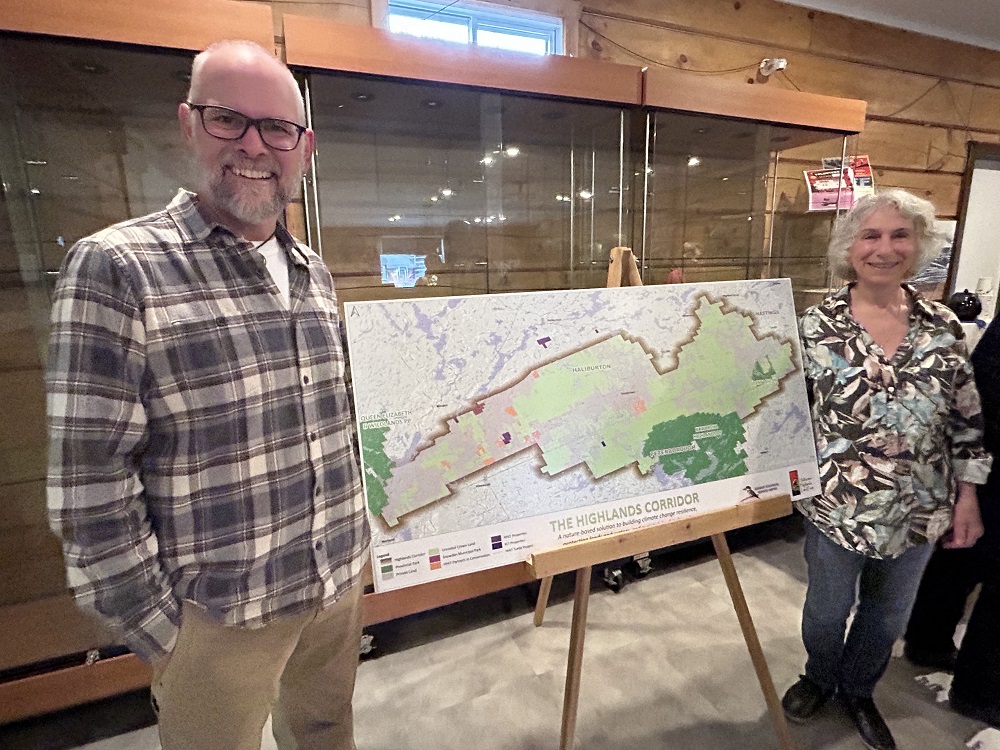Paul Heaven said efforts to protect a 100,000-hectare parcel of land connecting the Haliburton Highlands to three provincial parks progressed well in 2023.
The Highlands Corridor initiative was introduced by the Haliburton Highlands Land Trust (HHLT) in 2020, seeking to protect an important wildlife corridor that would bridge the gap between the Queen Elizabeth II Wildlands Provincial Park, Kawartha Highlands Provincial Park, and Silent Lake Provincial Park.
Speaking at a recent HHLT event, Heaven said the team working on the project has defined 4,800 hectares of provincially significant wetlands in the area and is completing mapping all wetlands in the townships of Snowdon, Lutterworth, and Glamorgan.
“We’ve made tremendous headway… the work has provided us with the science to understand why we’re trying to protect the corridor, especially when it comes to the value of wetlands for flood attenuation and carbon storage,” Heaven said.
Referencing the significant flooding seen across the County in 2013, 2016, 2017, and 2019, Heaven said it’s important these wetlands be protected and maintained as they serve as natural sponges that trap and slowly release water. Without them, local flooding events could be catastrophic.
There are implications for wildlife too, Heaven noted. By connecting the three provincial parks, it will give animals the chance to escape areas where there’s disease, drought, fire, or lack of a sustainable food source and relocate elsewhere.
“Climate change and other threats pose big problems for our wildlife communities. If wildlife can’t move from an area experiencing issues, they die out. The way to mitigate that is to maintain, and improve, connectivity,” Heaven said. “That’s one of the biggest drivers of this whole project – to bring these core areas together and give wildlife the opportunity to move around.”
The corridor is home to 39 federal and provincial species at risk, 25 provincially significant species, and 42 regionally or locally significant species.
Approximately 60,000 hectares of the corridor is made up of Crown land, Heaven said. Haliburton County council passed a resolution of support for the corridor in February 2023, standing with HHLT in trying to establish the bulk of that land as a conservation reserve.
The remaining 40,000 ha is mostly private land, Heaven said. HHLT has established a new ‘building partners in conservation’ program, aiming to bring private landowners on board to help protect the corridor. Through that, the land trust has preserved around 1,800 hectares.
“We provide management plans, we get people enrolled in tax incentive programs, and generally speak of the importance of good stewardship,” Heaven said. “Private landowners have a tremendous role to play.”
While there has been some talk by some members of County council, notably Cec Ryall – deputy mayor in Highlands East – of using some of the land included in the corridor to explore housing opportunities, Heaven said there’s been no movement on that front.
“We’re a long way from nailing down boundaries. We’re willing and fully understanding that there’s going to be pieces [of land] where we’ll work with municipalities and community partners [to explore] other interests, so there will be lots of massaging,” Heaven said. “The focus now is on establishing the concept and highlighting the importance.
“We need climate change resiliency here in central and southern Ontario. As a country, we’re trying to have 30 per cent of our landscape protected by 2030. We’re only a third of the way there… we’ve got another [20 million hectares] we need to protect – we can’t have that all up north,” Heaven added.
“Our wildlife populations are at risk here, our towns are at risk of flooding, we need solutions here.”
HHLT has secured funding to map wetlands in Monmouth and has submitted a proposal to the province to do Cardiff, potentially in 2025. Heaven noted the land trust shares its mapping data with the County, which is used for planning purposes.





